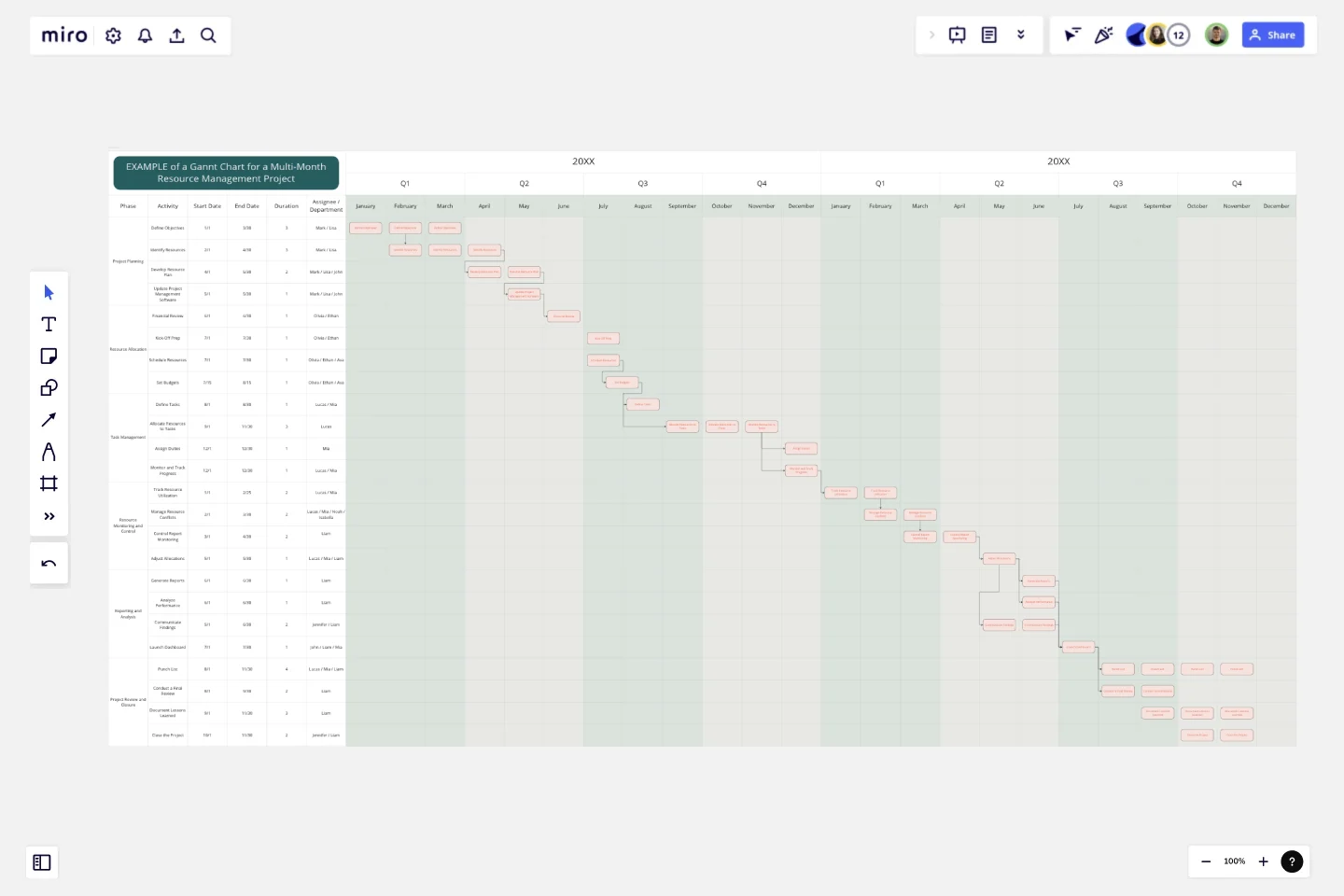Resource Management Gantt Chart
The Resource Management Gantt Chart template is designed to help teams efficiently plan, allocate, and manage resources throughout a project.
It provides a visual timeline for tasks and resource usage, ensuring that resources are optimally utilized and potential conflicts are identified early.
Key Features
Project Phases: Includes clearly defined phases relevant to resource management, such as Planning, Resource Allocation, Task Management, Monitoring and Control, Reporting, and Project Closure.
Task Breakdown: Allows for a detailed listing of tasks or milestones within each phase. This ensures that all necessary activities are planned and tracked.
Timeline Visualization: Offers a visual representation of the project timeline, including start and end dates for each task. This helps in scheduling and understanding resource demands over time.
Resource Allocation: Provides columns to assign and track resources (such as team members, equipment, and materials) for each task, ensuring clear visibility of who or what is involved.
Dependency Tracking: Shows dependencies between tasks, indicating which tasks need to be completed before others can start. This helps in coordinating resources and scheduling effectively.
Progress Tracking: Includes sections for updating the status of each task and resource utilization, making it easier to monitor progress and make necessary adjustments.
Resource Utilization: Helps in managing and optimizing resource use by providing an overview of how and when resources are being allocated.
Conflict Identification: Assists in identifying and resolving resource conflicts or over-allocations by providing a clear view of resource assignments and schedules.
Why Use the Resource Management Gantt Chart Template?
Organized Resource Planning: Helps structure and organize resource planning, ensuring that all resources are accounted for and allocated appropriately throughout the project.
Visual Clarity: Provides a clear, visual timeline of the project and resource usage, making it easy to understand scheduling and resource demands.
Efficient Allocation: Facilitates effective allocation of resources by showing which resources are needed for which tasks and when, helping to prevent overallocation or shortages.
Improved Coordination: By showing task dependencies and resource assignments, it aids in coordinating efforts among team members and avoiding scheduling conflicts.
Enhanced Tracking: Allows for regular updates and tracking of both task progress and resource utilization, ensuring that the project stays on track and resource issues are addressed promptly.
Informed Decision-Making: Supports better decision-making by providing a structured and comprehensive view of resource management, helping to make adjustments as needed.
When to Use This Template:
For Complex Projects: When managing multiple resources and tasks, this template helps to ensure that resources are allocated efficiently and project timelines are adhered to.
When Coordinating Teams: To clearly assign and track responsibilities and resources, especially in projects involving multiple team members or departments.
For Resource Optimization: To manage and optimize resource use, avoiding conflicts and ensuring that resources are used effectively throughout the project.
The Resource Management Gantt Chart template is a valuable tool for managing project resources, providing clarity, structure, and efficiency in resource planning and utilization.
This template was created by Anthony.
Get started with this template right now.
8 Different Ways to Organize Your Backlog
Works best for:
Agile
Explore 8 different techniques for managing and prioritizing work effectively with this template. From prioritization matrices to story mapping, it offers a comprehensive overview of backlog management strategies. By understanding the strengths and limitations of each approach, teams can tailor their backlog organization to optimize workflow, empowering teams to stay organized and focused on delivering value.
Inspired: Creating Products Customers Love
Works best for:
Product Management, Planning
Inspired: Creating Products Customers Love template guides product managers in developing innovative and customer-centric products. By emphasizing empathy, ideation, and validation, this template fosters a deep understanding of customer needs and preferences. With sections for brainstorming ideas, defining features, and validating concepts, it facilitates the creation of compelling products that resonate with target audiences. This template serves as a roadmap for delivering exceptional customer experiences and driving product success.
Product Hypothesis Canvas
Works best for:
Product Management, Planning
The Product Hypothesis Canvas template assists product teams in formulating and testing hypotheses effectively. By defining assumptions, success metrics, and validation experiments, this template guides teams through the hypothesis validation process. With sections for articulating problem statements, proposed solutions, and expected outcomes, it ensures that hypotheses are clear, testable, and aligned with strategic objectives. This template serves as a framework for hypothesis-driven product development, enabling teams to validate ideas and make data-informed decisions.
Strategy Map Template
Works best for:
Leadership, Strategic Planning, Mapping
How do your individual or team goals relate to an organization’s overall strategy? A Strategy Map is a stylized picture of your organization’s strategy and objectives. It’s powerful because it provides a clear visual guide to how these various elements work together. Strategy Maps can help align various different team goals with the overall strategy and mission. With the Strategy Map in place, teams can create set actionable, relevant KPIs. Strategy mapping is often considered part of the balanced scorecard (BSC) methodology, which is a strategic planning tool for setting overall team goals.
Customer Journey Map by Hustle Badger
Works best for:
Customer Journey Map
Customer journey mapping is a method that visualizes and narrates how users navigate a site or app to achieve their objectives.
Four-Circle Venn Diagram by Irfan Rosli
Works best for:
Venn Diagrams
The Four Circle Venn Diagram template offers a robust tool for detailed data comparison involving four sets. Use it to identify common and unique attributes across multiple categories. This template is perfect for complex analysis in research, strategic planning, and education. It helps visualize relationships clearly, making it easier to draw insights and communicate findings. Ideal for professionals and educators needing advanced comparative tools.
